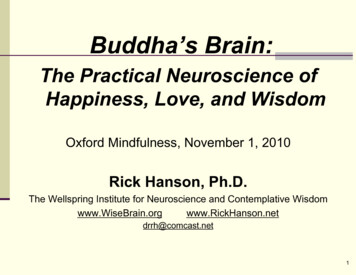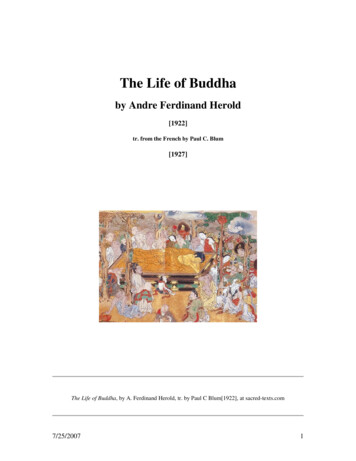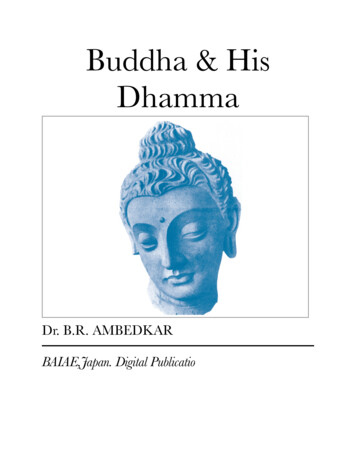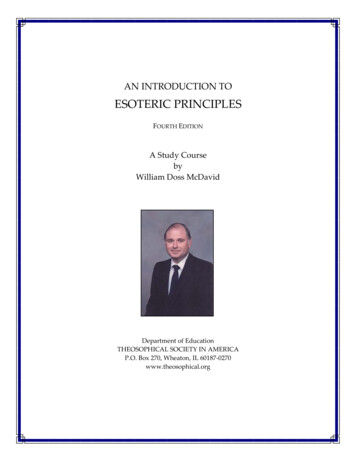
Transcription
Buddha’s Brain:The Practical Neuroscience ofHappiness, Love, and WisdomOxford Mindfulness, November 1, 2010Rick Hanson, Ph.D.The Wellspring Institute for Neuroscience and Contemplative ast.net1
Topics!! Self-directed neuroplasticity!! “Doing” and “Being”!! Taking in the Good!! No self, no problem2
Perspectives3
Common - and Fertile - GroundNeurosciencePsychologyContemplative Practice4
The history of science is rich in the exampleof the fruitfulness of bringingtwo sets of techniques, two sets of ideas,developed in separate contextsfor the pursuit of new truth,into touch with one another.J. Robert Oppenheimer5
Do not go by oral tradition, by lineage of teaching, by hearsay, by acollection of texts, by logic, by inferential reasoning,by reasoned cognition, by the acceptance of a view after pondering it, bythe seeming competence of a speaker,or because you think, “this . . . is our teacher.”But when you know for yourselves, “these things are wholesome, thesethings are blameless; these things are praisedby the wise; these things, if undertaken and practiced,lead to welfare and happiness,”then you should engage in them.The Buddha6
"We ask, 'What is a thought?’We don't know,yet we are thinking continually."Venerable Ani Tenzin Palmo7
Self-Directed Neuroplasticity8
A Neuron9
The Connectome - 210
As your mind changes, your brain changes.Immaterial mental activity maps to material neural activity.This produces temporary changes in your brain and lasting ones.Temporary changes include:!!!!!!Alterations in brainwaves ( changes in the firing patterns ofsynchronized neurons)Increased or decreased use of oxygen and glucoseEbbs and flows of neurochemicals11
The Rewards of Love12
Tibetan Monk, Boundless Compassion13
Christian Nuns, RecallingProfound Spiritual ExperiencesBeauregard, et al., Neuroscience Letters, 9/25/0614
Mind Changes Brain in Lasting Ways!! What flows through the mind sculpts your brain.Immaterial experience leaves material traces behind.!! Increased blood/nutrient flow to active regions!! Altered epigenetics (gene expression)!! “Neurons that fire together wire together.”!!!!!!!!Increasing excitability of active neuronsStrengthening existing synapsesBuilding new synapses; thickening cortexNeuronal “pruning” - “use it or lose it”15
Lazar, et al. 2005.Meditationexperience isassociatedwith increasedcortical thickness.Neuroreport, 16,1893-1897.16
Physical Effects of Meditation!! Strengthens anterior (frontal) cingulate cortex and insula - forimproved attention, empathy, and compassion!! Reduces cortical thinning with aging in activated regions!! Increases activation of left frontal regions, which lifts mood!! Increases power and reach of gamma-range brainwaves!! Decreases stress-related cortisol!! Strengthens immune system17
The Power of Mindfulness!! Attention is like a spotlight, illuminating what it rests upon.!! Because neuroplasticity is heightened for what’s in thefield of focused awareness, attention is also like a vacuumcleaner, sucking its contents into the brain.!! Directing attention skillfully is therefore a fundamental wayto shape the brain - and one’s life over time.The education of attentionwould be an education par excellence.William James18
Neuroplasticity in Context!! Neuroplasticity is not breaking news. It’s been longpresumed that mental activity changed neuralstructure: what else is learning?!! The news is in how the mind changes the brain.!! Most neuroplasticity is incremental, not dramatic.!! Neuroplasticity is ethically neutral.19
Grounding in the Brain - Benefits!! Organizing framework!!!!Evolutionary neuropsychologyCommon ground across theories and methods!! Motivating to clients, clinicians, policy-makers!!!!Concrete, in the body, physicalStatus of medicine, hard science!! Highlighting key principles and practices!!!!Implicit memoryNonverbal processes!! Innovating with truly new methods!!!!NeurofeedbackFear extinction20
Grounding in the Brain - Pitfalls!! Adding little new meaning!! Replacing psych terms with neuro (“amygdala made me do it”)!! Over-simplifying!! Over-localizing function (e.g., empathy mirror neurons)!! Exaggerated terms (“God-gene,” “female brain”)!! Materialistic reductionism, though brain and mind co-arise!! Claiming authority!! Using neuro data to argue a political or cultural case!! Using the secular religion of science to elevate status!! Underestimating the mind!! Most big changes in psyche involve tiny changes in soma; mentalplasticity holds more promise than neural plasticity.!! Overlooking the insights and effectiveness of psychology!! Ducking existential choices in values21
Foundations of Meditation!! Setting an intention - “top-down” frontal, “bottom-up” limbic!! Relaxing the body - parasympathetic nervous system!! Feeling safer - inhibits amygdala/ hippocampus alarms!! Evoking positive emotion - dopamine, norepinephrine!! Whole body and panoramic awareness - lateral networks!! Absorbing the benefits - positive implicit memories22
Medial and Lateral Networks23
Dual Modes“Doing”Focused attentionGoal-directedSense of cravingPersonal, self-oriented perspectiveLost in thought, mind wanderingConceptualFuture- or past-focusedMuch verbal activityFirm beliefsEvaluativeLooping contents of mindTightly connected experiencesFocal viewProminent self-as-objectProminent self-as-subject“Being”Open awarenessNothing to do, nowhere to goSense of peaceImpersonal, 3rd person perspectiveMindful presenceSensoryNow-focusedLittle verbal activityUncertainty, not-knowingNonjudgmentalTransient contents of mindLoosely connected experiencesPanoramic viewMinimal or no self-as-objectMinimal or no self-as-subject24
Increased Medial PFC ActivationRelated to Self-Referencing ThoughtGusnard D. A., et.al. 2001. PNAS, 98:4259-426425
Self-Focused (blue) and Open Awareness (red) Conditions(in the novice, pre MT group)26
Self-Focused (blue) and Open Awareness (red) Conditions(following 8 weeks of MT)27
Dual Modes“Doing”Focused attentionGoal-directedSense of cravingPersonal, self-oriented perspectiveLost in thought, mind wanderingConceptualFuture- or past-focusedMuch verbal activityFirm beliefsEvaluativeLooping contents of mindTightly connected experiencesFocal viewProminent self-as-objectProminent self-as-subject“Being”Open awarenessNothing to do, nowhere to goSense of peaceImpersonal, 3rd person perspectiveMindful presenceSensoryNow-focusedLittle verbal activityUncertainty, not-knowingNonjudgmentalTransient contents of mindLoosely connected experiencesPanoramic viewMinimal or no self-as-objectMinimal or no self-as-subject28
Ways to Activate “Being” Mode!! Relax.!! Focus on bare sensations and perceptions.!! Sense the body as a whole.!! Take a panoramic, “bird’s-eye” view.!! Engage “don’t-know mind”; release judgments. !!! Don’t try to connect mental contents together.!! Let experience flow, staying here now.!!! Relax the sense of “I, me, and mine.”29
Whole Body Awareness!! Sense the breath in one area (e.g., chest, upper lip)!! Sense the breath as a whole: one gestalt, percept!! Sense the body as a whole, a whole body breathing!! Sense experience as a whole: sensations, sounds,thoughts . . . all arising together as one unified thing!! It’s natural for this sense of the whole to be presentfor a second or two, then crumble; just open up to itagain and again.30
Panoramic Awareness!! Recall a bird’s-eye view (e.g., mountain, airplane).!! Be aware of sounds coming and going in an open space ofawareness, without any edges: boundless.!! Open to other contents of mind, coming and going like cloudsmoving across the sky.!! Pleasant or unpleasant, no matter: just more clouds!! No cloud ever harms or taints the sky.Trust in awareness, in being awake, !rather than in transient and unstable conditions.!31
“Bahiya, you should train yourself thus.”In reference to the seen, there will be only the seen. To the heard, only theheard. To the sensed, only the sensed. To the cognized, only thecognized. !When for you there will be only the seen in reference to the seen, only theheard in the heard, only the sensed in the sensed, only the cognized inthe cognized, then, Bahiya, there’s no you in that. !When there’s no you in that, there’s no you there. When there’s no youthere, you are neither here nor yonder nor between the two. !This, just this, is the end of all suffering. !The Buddha32
Taking in the Good33
Negativity Bias: Causes in Evolution!! “Sticks” - Predators, natural hazards, socialaggression, pain (physical and psychological)!! “Carrots” - Food, sex, shelter, social support,pleasure (physical and psychological)!! During evolution, avoiding “sticks” usually had moreeffects on survival than approaching “carrots.”!!!!Urgency - Usually, sticks must be dealt with immediately,while carrots allow a longer approach.Impact - Sticks usually determine mortality, carrots not; if youfail to get a carrot today, you’ll likely have a chance at acarrot tomorrow; but if you fail to avoid a stick today - whap! 34-
Negativity Bias: Some Consequences!! Negative stimuli get more attention and processing;we generally learn faster from pain than pleasure.!! People work harder to avoid a loss than attain anequal gain (“endowment effect”).!! Easy to create learned helplessness, hard to undo!! Negative interactions: more powerful than positive!! Implicit memory: the brain is like Velcro for negativeexperiences, but Teflon for positive ones.35
Key Consequence of the Negativity Bias:Threat Reactivity!! Two mistakes:!!!!Thinking there is a tiger in the bushes when there isn’t one.Thinking there is no tiger in the bushes when there is one.!! We evolved to make the first mistake a hundred timesto avoid making the second mistake even once.!! This evolutionary tendency is intensified bytemperament, personal history, culture, and politics.!! Threat reactivity affects individuals, couples, families,organizations, nations, and the world as a whole.36
Results of Threat Reactivity(Personal, Organizational, National)!! Our initial appraisals are mistaken:Overestimating threats!! Underestimating opportunities!! Underestimating inner and outer resources!!!! We update these appraisals with information thatconfirms them; we ignore, devalue, or alterinformation that doesn’t.!! Thus we end up with views of ourselves, others, andthe world that are ignorant, selective, and distorted.37
Costs of Threat Reactivity(Personal, Organizational, National)!! Feeling threatened feels bad, and triggers stress consequences.!! We over-invest in threat protection.!! The boy who cried tiger: flooding with paper tigers makes itharder to see the real ones.!! Acting while feeling threatened leads to over-reactions, makesothers feel threatened, and creates vicious cycles.!! The Approach system is inhibited, so we don’t pursueopportunities, play small, or give up too soon.!! In the Attach system, we bond tighter to “us,” with more fear and38
A Poignant TruthMother Nature is tilted toward producing gene copies.But tilted against personal quality of life.And at the societal level, we have caveman/cavewomanbrains armed with nuclear weapons.What shall we do?39
We can deliberately use the mind !to change the brain for the better.40
The Importance of Inner Resources!! Examples:!!!!!!!!!!Character virtuesPositive introjectsCorrective emotional experiences in psychotherapyLearned optimismBrahmaviharas; Paramittas; awakening factors!! Benefits!!!!!!!!!!Increase positive emotions: physical and mental healthImprove self-soothingImprove outlook on world, self, and futureIncrease resilience, determinationPromote prosocial behaviors41
Mindfulness, Virtue, Wisdom!! Mindfulness (or “concentration”), virtue, andwisdom are identified in Buddhism and othercontemplative traditions as the pillars of practice.!! In Western psychology, these are the foundations ofmental health and well-being.!! These three pillars map to three core functions of thenervous ing/selecting42
“Know the Mind, Shape the Mind, Free the Mind”!! Mindfulness, virtue, and wisdom - and their neural correlates -also map to three phases of practice:!!!!!!Be aware of the garden, pull weeds, plant flowers.Be mindful of, release, replace.Let be, let go, let in.!! People vary in their inclinations and strengths with the phases.!! Sometimes we need to take in resources in the third phase inorder to bear our own experience.!! Mindfulness is key to the second and third phase, sometimescurative on its own, and always beneficial in strengthening itsneural substrates. But often it is not enough by itself.43
Just having positive experiences is not enough. !They pass through the brain like water through asieve, while negative experiences are caught.!We need to engage positive experiences actively toweave them into the brain.!Thus making the brain like Velcro for positiveexperiences, and Teflon for negative ones.44
How to Take in the Good1. Look for positive facts, and let them become positiveexperiences.2. Savor the positive experience:!! Sustain it for 10-20-30 seconds.!! Feel it in your body and emotions.!! Intensify it.3. Sense and intend that the positive experience issoaking into your brain and body - registering deeplyin emotional memory.45
Why It’s Good to Take in the Good!! In general, adds positive contents to implicit memory!! Internalizes psychological growth (e.g., it usually feelsgood and goes well to speak from my heart)!! Associates rewards to good steps; boosts motivation!! Brings in missing “supplies” (e.g., love, worth) to helpremedy deficits and heal painful experiences!! Encourages prosocial experiences and actions46
Potential Synergies of TIG and MBSR!! Improved mindfulness from MBSR enhances TIG.!! TIG increases general resources for MBSR (e.g., heighten thePNS activation that promotes stable attention).!! TIG increases specific factors of MBSR (e.g., self-acceptance,self-compassion, tolerance of negative affect)!! TIG heightens internalization of key MBSR experiences:!! The sense of stable mindfulness itself!! Confidence that awareness itself is not in pain, upset, etc.!! Presence of supportive others (e.g., MBSR groups)!! Peacefulness of realizing that experiences come and go47
The Fourth Step of TIG!! When you are having a positive experience:!! Sense the current positive experience sinking down into old pain,and soothing and replacing it.!! When you are having a negative experience:!! Bring to mind a positive experience that is its antidote.!! In both cases, have the positive experience be big and strong, inthe forefront of awareness, while the negative experience issmall and in the background.!! You are not resisting negative experiences or getting attachedto positive ones. You are being kind to yourself and cultivatingpositive resources in your mind.48
Psychological AntidotesApproaching Opportunities!! Satisfaction, fulfillment -- Frustration, disappointment!! Gladness, gratitude -- Sadness, discontentment, “blues”Affiliating with “Us”!! Attunement, inclusion -- Not seen, rejected, left out!! Recognition, acknowledgement -- Inadequacy, shame!! Friendship, love -- Abandonment, feeling unloved or unlovableAvoiding Threats!! Strength, efficacy -- Weakness, helplessness, pessimism!! Safety, security -- Alarm, anxiety!! Compassion for oneself and others -- Resentment, anger49
Penetrative insight !joined with calm abiding !utterly eradicates !afflicted states.!Shantideva50
No Self, No Problem51
Definitions!! Person - The body-mind as a whole!!!!!!Contains knowledge, personal memories, skills,temperament, personality tendencies, mood, etc.Has considerable consistency over timeDeserves kindness and justice; is morally culpable!! Self - “I, me, and mine”!!!!Psychological self; the “I” in “I am happy, I want a cookie, Iknow 2 2 4, I am for justice”; the “me” in “Do you love me?”The apparent owner of experiences and agent of actions!! Awareness - The field in which the mind (as yetmysteriously) represents aspects of the mind to itself!!“Global workspace” in which representations of the person, 52
Conventional Notions of “Self”!! Unified - coherent; just one; a being, an entity; someone looking out through your eyes.!! Stable - unchanging in its fundamentals; the core selfas a child still feels present in you today!! Independent - things happen to the self, but itremains free of their effects in its essence.!! Identity - That which one is; that with which there isthe greatest identification53
The dualistic ego-mind is essentially a survivalmechanism, on a par with the fangs, claws,stingers, scales, shells, and quills that otheranimals use to protect themselves. !By maintaining a separate self-sense, it attempts toprovide a haven of security.!Yet the very boundaries that create a sense of safetyalso leave us feeling cut off and disconnected.!John Welwood!54
Actual Experience of “Self”!! Compounded – Made up of many parts; one self vows toexercise early, another self turns off the alarm clock.!! Impermanent – More or less present at different times; differentaspects come forward at different times; there is a process ofselfing rather than a static, fixed, unchanging entity.!! Dependent – Developed in interactions with caregivers andpeers and encounters with the world; grounded in evolution;activating and deactivating as a means to the ends of theorganism; especially responsive to opportunities and threats;self organizes around clinging.!! Part of the person – There is awareness of aspects of self ascontents within awareness like any others.55
Brain activations of “selfing” - Gillihan, et al., Psych Bulletin, 1/200556
57
Properties of Self in Your Brain!! Compounded – Distributed systems and sub-systems; nohomunculus looking through your eyes!! Impermanent – Circuits light up and deactivate; fluid, transient!! Dependent – Dependent on neural structures and processes;dependent on the evolution of specialized neural tissues (e.g.,spindle cells); responsive to stimuli;!! Part of the person – Self-related activations in neural circuitryare just a tiny fraction of the total activations in the brain!!!!The neural circuitry associated with self representations orfunctions also performs many other activities unrelated to self.In the brain, self is not special.58
Subjectivity Doesn’t Equal a Subject!! Ordinary awareness has an inherent subjectivity, alocalization to a particular perspective (e.g., to mybody, not yours).!! The brain indexes across experiences of subjectivityto create an apparent subject.!! That apparent subject is elaborated and layeredthrough the maturation of the brain, notably regionsof the prefrontal cortex.!! But there is no subject inherent in subjectivity!59
What Self?In sum, from a neurological standpoint, the everydayfeeling of being a unified self is an utter illusion:!! The apparently coherent and solid “I” is actually builtfrom many neural subsystems, with no fixed center.!! The apparently stable “I” is is produced by variableand transient activations of neural circuits.!! The apparently independent “I” depends on neuralcircuitry, the evolutionary processes that built them,critical interactions with others to shape thosecircuits, and the stimuli of the moment.Neurologically, self is “empty” - without absolute,inherent existence.60
Selflessness is not a case of something that existed in the pastbecoming nonexistent. Rather, this sort of “self” issomething that never did exist. !What is needed is to identify as nonexistent something thatalways was nonexistent. !!The Dalai Lama!When we recognize that the things we identify as our self areimpermanent and bound up with suffering, we realize theylack the essential marks of authentic selfhood and wethereby stop identifying with them.!!Bhikkhu Bodhi !61
Self Is Like a Unicorn!! Self-related patterns of information and neural activity are asreal as those that underlie the smell of roses.!! But that which they point to – a unified, enduring, independent“I” – just doesn’t exist.!! Just because we have a sense of self does not mean that weare a self. The brain strings together heterogenous moments ofself-ing and subjectivity into an illusion of homogenouscoherence and continuity.!! Real representations in the brain of a horse point to somethingthat is also real. But the real representations of a unicorn in thebrain point to something that is not real.!! The real representations of the self in the brain point to another62
“Self” Has Its Uses!! A convenient way to distinguish one person from another!! Brings a sense of continuity to life’s experiences!! Adds verve and commitment to relationships!! People without self structures have impaired relationships.!! Self-related processes helped our ancestors succeed inincreasingly social hunter-gatherer bands in whichinterpersonal dynamics played a strong role in survival.!! The evolution of relationships fostered the evolution of selfand vice versa; the benefits of self have thus been a factorin the evolution of the brain.!! Self has been stitched into human DNA by reproductiveadvantages slowly accumulating across a hundredthousand generations.63
Selfing Leads to Suffering!! When “I, me, and mine” are mental objects like anyother, there’s no problem.!!For example, the Buddha routinely used “I” and “you.”!! But when we privilege self-representations throughidentifiying with them or defending or glorifyingthem . . . Then we suffer, and create suffering forothers.!! The key is to be able to move dextrously into andback out of self-representations; that’s skillful means.64
Blissful is passionlessness in the world,!The overcoming of sensual desires;!But the abolition of the conceit I am --!That is truly the supreme bliss.!The Buddha, Ud"na 2.1165
To study the Way is to study the self.!To study the self is to forget the self.!To forget the self is !To be enlightened by all things.Dogen66
Great BooksSee www.RickHanson.net for other great books.!! Austin, J. 2009. Selfless Insight. MIT Press.!! Begley. S. 2007. Train Your Mind, Change Your Brain. Ballantine.!! Carter, C. 2010. Raising Happiness. Ballantine.!! Hanson, R. (with R. Mendius). 2009. Buddha’s Brain: The Practical!!!!!!!!!!!!!!!!Neuroscience of Happiness, Love, and Wisdom. New Harbinger.Johnson, S. 2005. Mind Wide Open. Scribner.Keltner, D. 2009. Born to Be Good. Norton.Kornfield, J. 2009. The Wise Heart. Bantam.LeDoux, J. 2003. Synaptic Self. Penguin.Linden, D. 2008. The Accidental Mind. Belknap.Sapolsky, R. 2004. Why Zebras Don’t Get Ulcers. Holt.Siegel, D. 2007. The Mindful Brain. Norton.Thompson, E. 2007. Mind in Life. Belknap.67
Key Papers - 1See www.RickHanson.net for other scientific papers.!! Atmanspacher, H. & Graben, P. 2007. Contextual emergence of mental statesfrom neurodynamics. Chaos & Complexity Letters, 2:151-168.!! Baumeister, R., Bratlavsky, E., Finkenauer, C. & Vohs, K. 2001. Bad is strongerthan good. Review of General Psychology, 5:323-370.!! Braver, T. & Cohen, J. 2000. On the control of control: The role of dopamine inregulating prefrontal function and working memory; in Control of CognitiveProcesses: Attention and Performance XVIII. Monsel, S. & Driver, J. (eds.). MITPress.!! Carter, O.L., Callistemon, C., Ungerer, Y., Liu, G.B., & Pettigrew, J.D. 2005.Meditation skills of Buddhist monks yield clues to brain's regulation of attention.Current Biology. 15:412-413.68
Key Papers - 2!! Davidson, R.J. 2004. Well-being and affective style: neural substrates andbiobehavioural correlates. Philosophical Transactions of the Royal Society.359:1395-1411.!! Farb, N.A.S., Segal, Z.V., Mayberg, H., Bean, J., McKeon, D., Fatima, Z., andAnderson, A.K. 2007. Attending to the present: Mindfulness meditation revealsdistinct neural modes of self-reflection. SCAN, 2, 313-322.!! Gillihan, S.J. & Farah, M.J. 2005. Is self special? A critical review of evidencefrom experimental psychology and cognitive neuroscience. PsychologicalBulletin, 131:76-97.!! Hagmann, P., Cammoun, L., Gigandet, X., Meuli, R., Honey, C.J., Wedeen, V.J.,& Sporns, O. 2008. Mapping the structural core of human cerebral cortex. PLoSBiology. 6:1479-1493.!! Hanson, R. 2008. Seven facts about the brain that incline the mind to joy. InMeasuring the immeasurable: The scientific case for spirituality. Sounds True.69
Key Papers - 3!! Lazar, S., Kerr, C., Wasserman, R., Gray, J., Greve, D., Treadway, M.,McGarvey, M., Quinn, B., Dusek, J., Benson, H., Rauch, S., Moore, C., & Fischl,B. 2005. Meditation experience is associated with increased cortical thickness.Neuroreport. 16:1893-1897.!! Lewis, M.D. & Todd, R.M. 2007. The self-regulating brain: Cortical-subcorticalfeedback and the development of intelligent action. Cognitive Development,22:406-430.!! Lieberman, M.D. & Eisenberger, N.I. 2009. Pains and pleasures of social life.Science. 323:890-891.!! Lutz, A., Greischar, L., Rawlings, N., Ricard, M. and Davidson, R. 2004. Long-term meditators self-induce high-amplitude gamma synchrony during mentalpractice. PNAS. 101:16369-16373.!! Lutz, A., Slager, H.A., Dunne, J.D., & Davidson, R. J. 2008. Attention regulationand monitoring in meditation. Trends in Cognitive Sciences. 12:163-169.70
Key Papers - 4!! Rozin, P. & Royzman, E.B. 2001. Negativity bias, negativity dominance, andcontagion. Personality and Social Psychology Review, 5:296-320.!! Takahashi, H., Kato, M., Matsuura, M., Mobbs, D., Suhara, T., & Okubo, Y.2009. When your gain is my pain and your pain is my gain: Neural correlates ofenvy and schadenfreude. Science, 323:937-939.!! Tang, Y.-Y., Ma, Y., Wang, J., Fan, Y., Feng, S., Lu, Q., Yu, Q., Sui, D.,Rothbart, M.K., Fan, M., & Posner, M. 2007. Short-term meditation trainingimproves attention and self-regulation. PNAS, 104:17152-17156.!! Thompson, E. & Varela F.J. 2001. Radical embodiment: Neural dynamics andconsciousness. Trends in Cognitive Sciences, 5:418-425.!! Walsh, R. & Shapiro, S. L. 2006. The meeting of meditative disciplines andWestern psychology: A mutually enriching dialogue. American Psychologist,61:227-239.71
Where to Find Rick Hanson WiseBrain.org72
Buddha's Brain: The Practical Neuroscience of Happiness, Love, and Wisdom Oxford Mindfulness, November 1, 2010 Rick Hanson, Ph.D. The Wellspring Institute for Neuroscience and Contemplative Wisdom www.WiseBrain.org www.RickHanson.net drrh@comcast.net. 2 Topics!!










